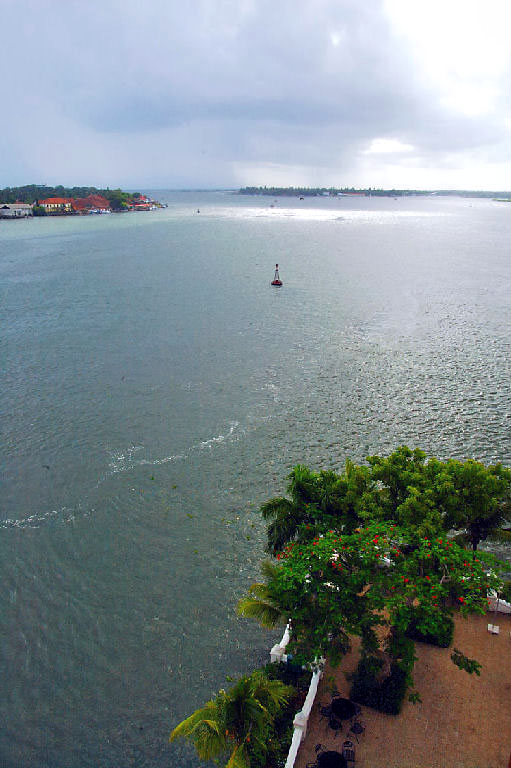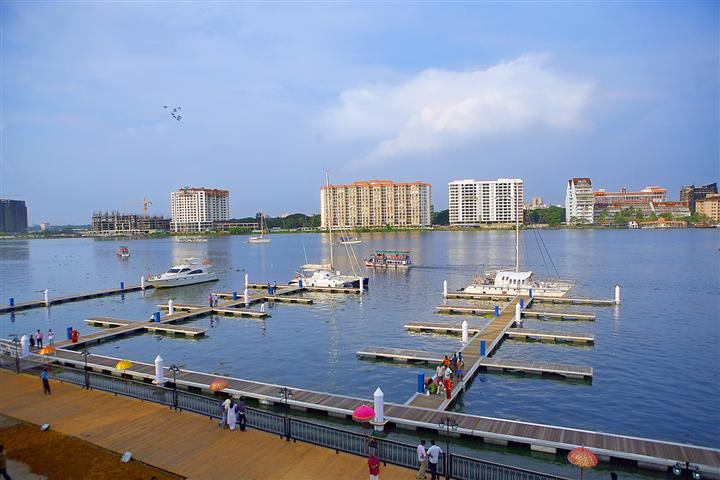|
Venduruthy
Venduruthy is a small island in Kochi, India. It is now a part of the greater Willingdon Island. The isolated island is approachable only from the Ernakulam backwater channel. It boasted of two edifices-the Roman Catholic Church of Saint Peter and Saint Paul, it was built by the early Portuguese settlers in the 16th century. In 1925 when the late Marquis of Willingdon was Governor of Madras Province, the question of reclaiming this boggy marshland arose in Parliament and after many heated debates, reclamation was put into operation, lasting over a period of twenty years, eventually producing an island of no mean size. Black heavy clay silt was scoured from the channel bed by the dredger Lord Willingdon and deposited in vast quantities upon the site, whilst around the perimeter a strong four-foot stone wall was constructed as a safeguard against inroads from the sea. Trees were planted along the coast to keep the soil firm. Within a decade the island which is now named Willing ... [...More Info...] [...Related Items...] OR: [Wikipedia] [Google] [Baidu] |
INS Venduruthy
INS Venduruthy is an Indian Navy base located on Willingdon Island in Kochi, Kerala. It serves as the Headquarters of the Southern Naval Command. It is the largest training establishment of the Indian Navy. INS Garuda is a naval air station located adjacent to INS Venduruthy. Commodore Deepak Kumar is the Commanding officer of this base. It provides administrative facilities to all training establishments inside the Southern naval command. Pincode of INS Vendurathy is 682004. History Willingdon Island was reclaimed from Kochi Lake to aid the construction of the Port of Kochi in 1936. A small naval unit was set up at the location just two days prior to the outbreak of World War II. During the war, the rudimentary air strip near the port was transferred to the Royal Air Force in 1941. On 22 June 1943, the facilities were transferred to the Royal Navy. With the ongoing war, the base quickly expanded to become the headquarters of the Royal Navy in southern India. In 1946, after ... [...More Info...] [...Related Items...] OR: [Wikipedia] [Google] [Baidu] |
Kochi (India)
Kochi (), also known as Cochin ( ) ( the official name until 1996) is a major port city on the Malabar Coast of India bordering the Laccadive Sea, which is a part of the Arabian Sea. It is part of the district of Ernakulam in the state of Kerala and is commonly referred to as Ernakulam. Kochi is the most densely populated city in Kerala. As of 2011, it has a corporation limit population of 677,381 within an area of 94.88 km2 and a total urban population of more than of 2.1 million within an area of 440 km2, making it the largest and the most populous metropolitan area in Kerala. Kochi city is also part of the Greater Cochin region and is classified as a Tier-II city by the Government of India. The civic body that governs the city is the Kochi Municipal Corporation, which was constituted in the year 1967, and the statutory bodies that oversee its development are the Greater Cochin Development Authority (GCDA) and the Goshree Islands Development Authority (GIDA). ... [...More Info...] [...Related Items...] OR: [Wikipedia] [Google] [Baidu] |
Willingdon Island
Willingdon Island is the largest artificial island in India, which forms part of the city of Kochi, in the state of Kerala. Much of the present Willingdon Island was claimed from the Lake of Kochi, filling in dredged soil around a previously existing, but tiny, natural island. Willingdon Island is significant as the home for the Port of Kochi as well as the Kochi Naval Base, the Southern Naval Command of the Indian Navy, Plant Quarantine station, Custom House Cochin and Central Institute of Fisheries Technology, a constituent unit of Indian Council of Agricultural Research. The island is also home for other establishments associated with the port, namely, the ''Office of the'' Cochin Port Trust (that controls the Port of Kochi), the Customs Office'','' and more than two dozen export-import offices, warehouses, a few hotels and business centers. History Conception The idea of developing a new port in Kochi was first felt by Sir Robert Bristow, who was appointed by ... [...More Info...] [...Related Items...] OR: [Wikipedia] [Google] [Baidu] |
Ernakulam
Ernakulam () is the Central Business District of the city of Kochi in Kerala, India and has lent its name to the Ernakulam district. Many major establishments, including the Kerala High Court, the office of the Kochi Municipal Corporation and the Cochin Shipyard are situated here. History Classical history The region can claim to have played a significant part in fostering the trade relations between Kerala and the outside world in the ancient and medieval period. The early political history of Ernakulam is interlinked with that of the Chera Dynasty of the Sangam age, who ruled over vast portions of Kerala and Tamil Nadu. After the Cheras, the place was later ruled by the Kingdom of Cochin (Perumpadapu Swaroopam). Princely State of Cochin Although under British suzerainty (specifically the East India Company) since the Anglo-Dutch Treaty of 1814, Rama Varma XII of the Kingdom of Cochin moved his capital from Mattancherry to Tripunithura in about 1840. Fort Cochin Mun ... [...More Info...] [...Related Items...] OR: [Wikipedia] [Google] [Baidu] |
Shrubbery
A shrubbery, shrub border or shrub garden is a part of a garden where shrubs, mostly flowering species, are thickly planted. The original shrubberies were mostly sections of large gardens, with one or more paths winding through it, a less-remembered aspect of the English landscape garden with very few original 18th-century examples surviving. As the fashion spread to smaller gardens, linear shrub borders covered up walls and fences, and were typically underplanted with smaller herbaceous flowering plants. By the late 20th century, shrubs, trees and smaller plants tend to be mixed together in the most visible parts of the garden, hopefully blending successfully. At the same time, shrubs, especially very large ones, have become part of the woodland garden, mixed in with trees, both native species and imported ornamental varieties. The word is first recorded by the OED in a letter of 1748 by Henrietta Knight, Lady Luxborough to the fanatical gardener William Shenstone: "Nature ... [...More Info...] [...Related Items...] OR: [Wikipedia] [Google] [Baidu] |
Wharf
A wharf, quay (, also ), staith, or staithe is a structure on the shore of a harbour or on the bank of a river or canal where ships may dock to load and unload cargo or passengers. Such a structure includes one or more berths (mooring locations), and may also include piers, warehouses, or other facilities necessary for handling the ships. Wharves are often considered to be a series of docks at which boats are stationed. Overview A wharf commonly comprises a fixed platform, often on pilings. Commercial ports may have warehouses that serve as interim storage: where it is sufficient a single wharf with a single berth constructed along the land adjacent to the water is normally used; where there is a need for more capacity multiple wharves, or perhaps a single large wharf with multiple berths, will instead be constructed, sometimes projecting over the water. A pier, raised over the water rather than within it, is commonly used for cases where the weight or volume of cargos will b ... [...More Info...] [...Related Items...] OR: [Wikipedia] [Google] [Baidu] |
Lord Willingdon
Freeman Freeman-Thomas, 1st Marquess of Willingdon (12 September 1866 – 12 August 1941), was a British Liberal politician and administrator who served as Governor General of Canada, the 13th since Canadian Confederation, and as Viceroy and Governor-General of India, the country's 22nd. Freeman-Thomas was born in England and educated at Eton College and then the University of Cambridge before serving for 15 years in the Sussex Artillery. He then entered the diplomatic and political fields, acting as aide-de-camp to his father-in-law when the latter was Governor of Victoria and, in 1900, was elected to the British House of Commons. He thereafter occupied a variety of government posts, including secretary to the British prime minister and, after being raised to the peerage as Lord Willingdon, as Lord-in-waiting to King George V. From 1913, Willingdon held gubernatorial and viceregal offices throughout the British Empire, starting with the governorship of Bombay and then the ... [...More Info...] [...Related Items...] OR: [Wikipedia] [Google] [Baidu] |

.jpg)




